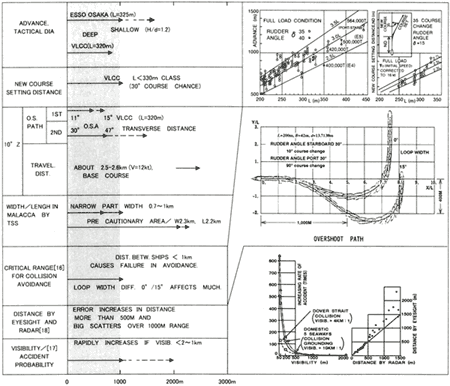|
5. PROPOSAL TO CRITERIA FOR MANOEUVRABILITY DESIGN BASED ON EVALUATIONS FOR SHIP-HANDLING PERFORMANCE
5.1 Sea Surface Occupied by Ship's Paths Related to Restricted Seaways and Limitation of Avoidance
Occupied sea surfaces mentioned in Section 2 are collected in Table 2 together with those in Fig. 1. One of the studies for the accident analysis and the avoidance limitation by simulations point that the transverse of a ship with loop width of 15°is significantly large than the one with 0°loop width in manoeuvring after counter rudder [16]. In a study about visibility and accident, the author stresses that danger increases rapidly if visibility decreases below 1,000m [17][18]. If we look at the figures of Table 2 comprehensively, it will be said that VLCC class vessels should have the manoeuvrability which enables the position control within 1,000m. It has been used to estimate the allowance of loop width in operational point on the basis of the relationship between the loop width and 1st overshoot angle of 10°Z, as sown in Fig. 6 [19][20] however, careful attention should be payed to some of the recent points over these lines which might lead optimistic estimations. Relationships between the 1st and 2nd overshoot angles and the loop width are introduced in Korea [21]. In order to decrease the overshoot angles, high lift rudders like Shilling rudders as shown in Fig. 7 [22][23] could be adopted as counter-measures.
Fig.5 Relationships between check helm and loop width.
Fig. 6 Loop width and 10°Z 1st overshoot heading angle.
5.2 Relationships Among the Author's Criteria, Operator's Comments and Loop Width
Table 3 shows the collection of typical ships of which operator's comments for insufficient manoeuvrability, loop width and the author's ranking for course stability in 6.2 are listed. By the consideration to the data in Table 3 together with the study up to 5.1, the author propose to limit the loop width within 5°〜6°as a guide for manoeuvrability design.
Fig.7 |
Comparison of time history of heading angle between Mariner and Shilling rudder. |
|
Table 2
|
Dimensional restrictions in seaway in connection with ship's path.
|
(Enlarged Image:119KB) |
 |
|